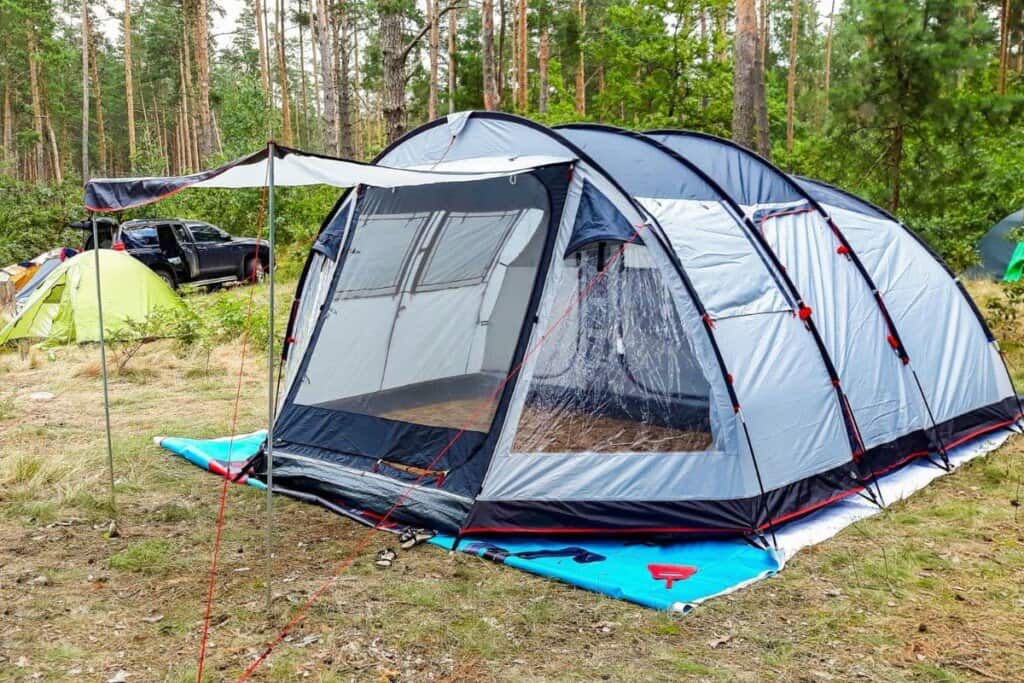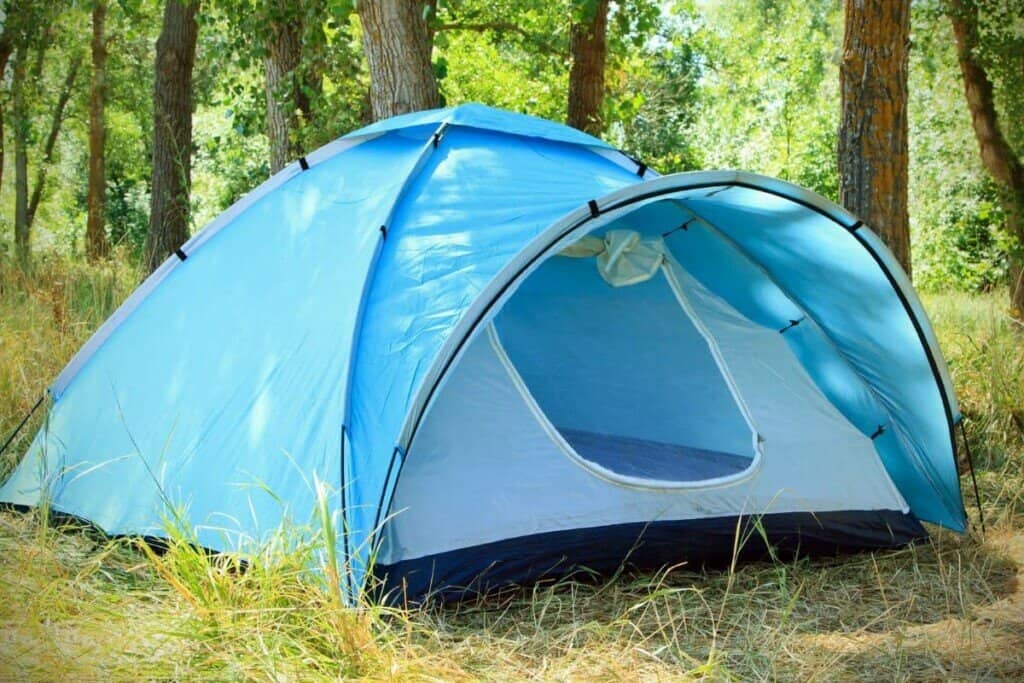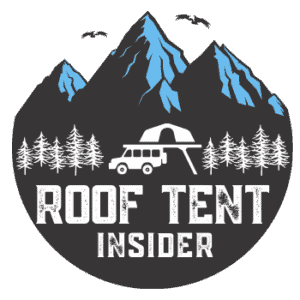If you’ve gone camping in the cold, you’re probably already aware of how difficult it is to remain warm in such weather. Tents are incredibly helpful because they trap in warm air, giving you a brief reprieve from the biting cold outside. However, you may have noticed that large tents do not remain as warm as smaller ones.
Bigger tents are colder than smaller tents because there’s more air to warm up within them. Your body warms up the air around you, and the tent traps the warm air inside its confines. Larger tents also take much longer to warm up because they have more space and, thus, more air.
In the rest of this article, I’ll explain why bigger tents are colder and how you can keep them warm. I’ll also discuss the best tents for cold-weather camping. So let’s dive in!

Why Bigger Tents Are Colder: The Science Explained
To understand why bigger tents remain colder, you first need to know how they warm up.
Essentially, the primary source of heat in a tent is your body. Your body is the first source of heat inside a tent.
Heat travels through different means, and the human body loses heat in several ways. For this article, I will focus on three methods: Respiration, Radiation, and Conduction.
How Tents Warm Through Radiation
The human body loses quite a lot of heat through the neck, head, wrists, and ankles. These areas have a higher concentration of blood vessels, which release more heat. This heat then warms up the air surrounding you.
In a typical, open setting, you wouldn’t notice the air around you heating up. That’s because the heated air dissipates and cools down almost immediately since there’s nothing insulating it. However, the warm air remains trapped in a small, closed space like the inside of a tent.
How Tents Warm Through Conduction
Conduction is how heat travels between solids. The heat (energy) travels from the solid to the colder one until both are roughly the same temperature.
In tents, this process occurs when you sleep on the tent floor. The heat travels from your body to the tent’s floor to heat the area. You may have noticed this phenomenon when lying on cold flooring like marble or granite.
How Tents Warm Through Respiration
The final way humans can warm up tents is through respiration. When we breathe in, we take in colder air. This cold air gets warmed up within our lungs and exhaled. Thus, the exhaled air is much warmer, warming up the tent.
Why Are Bigger Tents Colder?
Now that I’ve explained how our bodies warm up the tent, let me move on to why bigger tents are colder.
The size of the tent makes it very difficult to heat up with just one person. For a large tent, you would need the body heat of several people. Thus, large tents are suitable in the cold only for families or groups, not individuals.

With smaller tents, there’s less air trapped inside, making it quicker and easier to heat.
How Do You Keep a Large Tent Warm?
There are many ways to keep your tent and yourself warm during cold weather.
You can use insulating materials on the floor or a tent-safe heater to keep a larger tent warm. Body heat alone is not enough for large tents, so you need extra materials like padding. You can also wear warm clothes and thermals to retain body heat within large tents.
Let me explain some simple ways to keep your large tent warm.
Use Rooftop Tents
Although this is a bit of an unusual tip, rooftop tents can be warmer than regular ground tents. Since they’re not directly on the cold floor, you don’t have to worry about snow or ice beneath your tent.
In my article, you can learn more about ground and rooftop tents: Ground Tent vs. Truck Tent vs. Roof Top Tent: What’s The Difference?
Choose the Right Tent
Before you think about insulating your tent, it’s best to ensure you’ve got the right tent. In general, there are two broad classifications of tents. These classifications rest on the weather conditions manufacturers design them to withstand.
The first type is a 3-Season Tent. These tents withstand typical weather like light rain, light winds, etc. These tents are usually lightly built, compact, and easy to carry.
The second type is a 4-Season Tent. These are pretty sturdy and hefty. They’re suited to extreme weather like snowstorms, heavy rains, and harsh weather.
If you’re only expecting mildly cold weather, you can opt for a 3-Season Tent. I’d recommend the Big Agnes Tiger Wall Ultralight Tent, available on Amazon.com. This tent is extremely lightweight and features a 1-pole setup that makes it easy to put up and pack away. The two-door system and storm flaps make it great for cold, windy weather.
However, if you’re expecting harsher cold weather like heavy snow, you’ll need a 4-Season Tent. I recommend the REI Co-op Arete ASL 2 Tent (available on REI). Its 4-pole design makes it solid and sturdy and features adjustable vents to ensure maximum cross-ventilation. It’s also pretty lightweight—a rarity for 4-season tents!
Insulate the Tent Floor
Rugs and mats are excellent insulators and keep the warm air from escaping your tent. Find some thick, warm rugs, mats, or even blankets, and line the floor of your tent. These items will prevent you from sleeping on a cold floor where you can lose heat.
However, a better option for insulating your tent floors is to use foam padding. This Wakeman Foam Sleeping Pad is excellent for insulation. You need to unroll it and place your sleeping bag on top. The thick foam keeps your body heat from seeping into the floor.
Use a Tent-Safe Heater
Some heaters are safe to use and should be labeled “indoor safe” to be suitable for use.
Regular gas stoves for camping are not safe for use inside a tent. However, you can use propane, butane, or kerosene heaters inside the tent.
I’d recommend the Mr. Buddy Heater. Its best feature (in my opinion) is the automatic shut-off if it tips over. It is highly efficient (capable of heating spaces up to 200+ square feet or 18.58+ sq m), and the automatic shut-off also makes it safe to use while sleeping.
Be careful about carbon monoxide poisoning if you use a heater in a tent. I’ve written another guide to discuss the risks of using inside heaters. I’ve also recommended a safe heater to use inside a tent. [can you get carbon monoxide poisoning from a Mr buddy heater?]
Note: never use a heater if you suspect it’s leaking.
Wear Warm, Thick Clothing
Although this tip isn’t about heating the tent, it somewhat achieves that purpose. Wearing appropriate clothing will help you retain more body heat. So if you dress in thick clothes, you might not even notice if the tent is a bit colder.
I’d suggest getting thermals to wear beneath your regular clothing. The Thermajohn Men’s Thermals and Thermajane Women’s Thermals are great for cold weather. They’re both snug and comfortable and come in simple neutral colors. Both come in long-sleeved t-shirts and leggings sets, providing full coverage.
Final Thoughts
While bigger tents are more spacious and luxurious, they’re also much harder to heat up. In a smaller tent, body heat alone might be enough to warm the tent, but bigger tents need extra help.
You can use heaters or insulation to keep your tent warm. However, it’s more important to use a tent built for cold weather conditions. If you’re still feeling cold inside the tent, you can wear warmer clothing like thermals to retain body heat.
